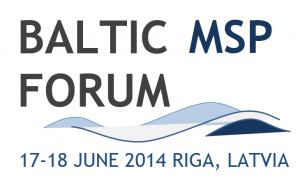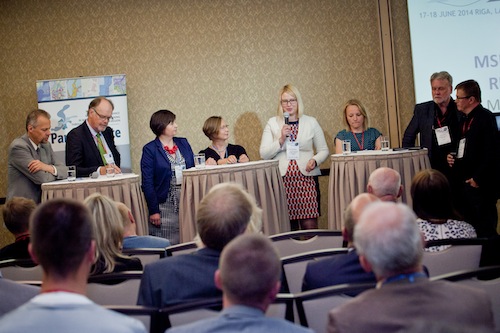Panel discussion: MSP in the Baltic SEA Region until 2020 – Expectations and challenges
Moderator: Jan Ekebom, Metsähallitus Natural Heritage Services
Panelists
- Haitze Siemers, EC DG for Maritime Affairs and Fisheries, Head of Unit for Maritime Policy in the Baltic and North Sea
- Thomas Johansson, Head of the Marine Spatial Planning and Maritime Affairs Division of the Swedish Agency for Marine and Water Management (SwAM)
- Katarzyna Krzywda, Polish Ministry of Infrastructure and Development, Department for Maritime Transport and Shipping Safety
- Tiina Tihlman, Finnish Ministry of the Environment
- Kristine Rasina, Ministry of Environmental Protection and Regional Development of Latvia
- Anni Konsap, Estonian Ministry of the Interior, Planning department
- Lars Emmelin, Blekinge Institute of Technology
Issues raised in the discussion
The panelists discussed how MSP is expected to develop in the near future.
From an EU perspective, the next step is the adoption of the directive by the European Council, which is expected for the second half of July. Apart from the adoption of the legal text, the MSP implementation process should start as early as possible with concrete and actionable measures, which go beyond the sometimes rather open legal provisions.
Finland has a long tradition in (land-based) spatial planning, including planning of territorial waters. Cooperation structures and participation culture are well established. The Office of the Prime Minster and the Ministry of Environment are responsible to discuss MSP relevant issues with maritime sectors.
In Estonia, MSP is currently a tool for conflict resolution. Furthermore, stakeholders still don’t know enough about the added value of MSP. A vision-based implementation of MSP is the aim in Estonia in the coming years.
In Sweden, not all relevant actors are familiar with MSP yet. By 2017 a plan should be developed. In the course of this process, efforts to involve actors in consultations should be kept up.
In Poland, cross-border consultations have already started. The Swedish counterparts were met twice, once in Visby and once in Warsaw. Data sharing was an important topic discussed during these meetings. Poland has been collecting data from different institutions for the last six months. The Polish Ministry of Infrastructure and Development passes on this data to the Maritime Institute to process it and convert it into information that is valuable to planners.
There are two approaches in terrestrial planning theory: ad-hoc problem solving and total planning (Aménagement du territoire). Both approaches lead to a different planning processes and different results. The directive tends to be oriented towards total planning. However, it was stated that the ad-hoc problem solving approach might be more pragmatic. Is seems easier to agree on problems that need to be solved than on a vision for a vast space. That is why visions tend to be rather vague.
The issue of knowledge exchange on MSP among sea basins was raised. There is definitely potential to share experience and learn from each other. However, planning is highly context specific. The own conditions need to be assessed and it needs to be carefully considered, in which cases lessons learned from another sea basin can be applied for one’s own case.
It has been stressed that planning is a complex process. The success of MSP very much depends on the planners. Therefore communication skills are most important. Moreover, planning is a “team sport” and depends on the expertise of people with very different backgrounds. Currently, there is only one comprehensive, dedicated university programme, namely the ERASMUS Mundus course on Maritime Spatial Planning.
The question arose what can be done about disputed borders in the context of MSP. The advise given was threefold: 1) not to get engaged in solving the border issues, 2) to work with the system by addressing problems at the appropriate level, and 3) to communicate with neighbouring countries.
 There is an interdependency of MSP and Blue Growth objectives. The ecosystem approach is designed to manage human activities, not nature itself. It should be the aim to produce maximum sustainable yield (in terms of value and jobs) from marine areas across time and space. Sustainability needs to be understood in its environmental, economic and social dimension. However, the example of unmanned ships shows how difficult it is to reconcile all aspects of sustainability as these unmanned ships produce value, but no jobs.
There is an interdependency of MSP and Blue Growth objectives. The ecosystem approach is designed to manage human activities, not nature itself. It should be the aim to produce maximum sustainable yield (in terms of value and jobs) from marine areas across time and space. Sustainability needs to be understood in its environmental, economic and social dimension. However, the example of unmanned ships shows how difficult it is to reconcile all aspects of sustainability as these unmanned ships produce value, but no jobs.
Another statement from the plenary was that planning itself does not produce anything, but at best sets conditions for other actors to act within. Many of these conditions take the form of restrictions. Planning is a driver of change and development, but it can also indicate which areas should be designated for cultural and natural heritage purposes and, thus, not be economically developed.



